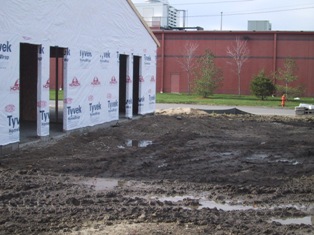 Construction sites are always muddy. Kitchens are always messy, at least while meals are being prepared.
Construction sites are always muddy. Kitchens are always messy, at least while meals are being prepared.
 People want assembly to be antiseptic, and free. It ain't. It takes time, and skill, to fit materials to the site, and the task, and craft them into an integrated whole. People don't want to live or work in prefab trailer park modules. They want real homes, real stores, real offices.
People want assembly to be antiseptic, and free. It ain't. It takes time, and skill, to fit materials to the site, and the task, and craft them into an integrated whole. People don't want to live or work in prefab trailer park modules. They want real homes, real stores, real offices.
I've been re-reading some of Christopher Alexander's work, and remain skeptical that either good buildings or good code can be seamlessly, effortlessly conjoured up out of Lego blocks.


This argument in the software realm which pits "off the shelf" code against the custom package, is reminiscent of the old debate within the English as a second language community wherein the Skinnerian-based advocates of the "audio-lingual" method squared off solidly against the "cognitive code" crowd led by Noam Chomsky and his research into transformational grammar.
The debate was often ugly and took on an overt political agenda. The "Skinnerians" were Luddites. Their emphasis on pattern practice of the language was deemed backward, mechanistic. Even reactionary.
The Chomsky camp was humanistic, progressive and scientific. It was a "thinking man's" club. It celebrated man's creative spirit within the complex theories of transformational grammar, as opposed to Skinner's more reptilian view of man, focusing only on language as mere pattern, a set of karaoke lyrics to be memorized and then repeated.
The truth was -- pattern practice was what most non-native English speakers students wanted, and it was effective. The transformational grammarians had an elegant unified field theory of grammar, but no nuts and bolts. No efficiently teachable elements.
As the debate wore on, it became clear that the Chomskyites were on to something. They just needed a decade or so to figure it out. But the teaching methods that were eventually created using transformational grammar as a guide did not negate the continuing need for pattern practice in the classroom.
Students would not be able to be taught a few "rules" and then come up with a critique of James Joyce's "Ulysees." They would not suddenly learn to speak eloquently only by listening to tapes of Rod McKuen while the "facilitator" (no longer a teacher) rubbed compentency-based phrases into their dilated linguistic pores.
Today, both camps concede a limited victory. Most contemporary teaching methods incorporate both a "left brain" dose of pattern practice modulated with a "right brain" dollop of natural language input and discussion.
Now, not knowing jackshit about computer software, I can only guess that this debate over whether or not the old code, the old "patterns," is as good as custom code is essentially divided along the same party lines as the language debates mentioned above.
People may not want to live in a trailer, but Lego blocks are still a LOT of fun. Folks may want a custom home, but the customization comes more in the form of archtecture (high ceilings, bathrooms as large as a football field) than it does in actual materials (a switch is a switch is a switch) and heated towel racks? Don't get me started.
And remember, people may want to live in a hundred year old home with stained glass windows and oak floors and cove molding, but it's either too expensive (those wealthy programmers have moved in and driven up the prices) or, it has suddenly become part of a "bad" neighborhood (those programmers just won't keep up their property).